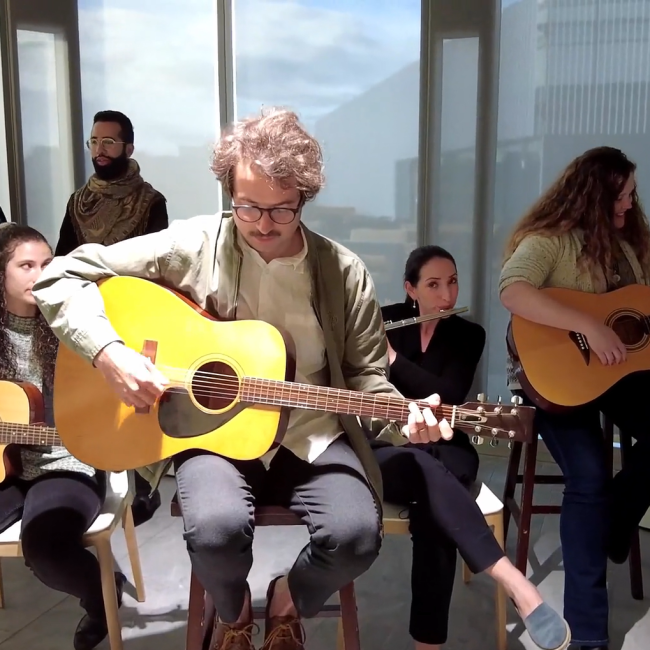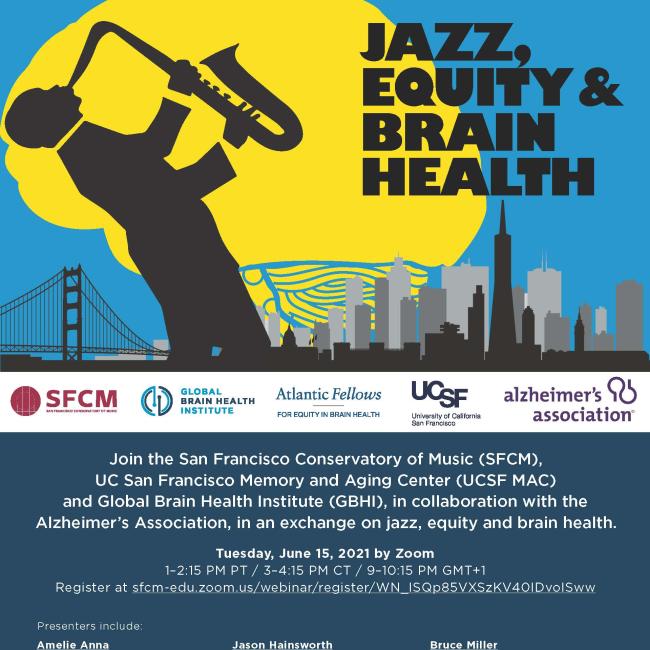Exploring Emotion and Music in Dyslexia
SAN FRANCISCO, CA—On February 4, the Global Brain Health Institute (GBHI), UCSF Memory and Aging Center, and UCSF Dyslexia Center joined the San Francisco Conservatory of Music (SFCM) to host “The Other Side of the Brain: Exploring Emotion & Music in Dyslexia,” the second installment in a new partnership exploring music, science and the brain.
“There are things we know through music we can’t know through other means,” said David Stull, president of SFCM, of the collaboration. “We seek to explore these questions.”
The Other Side of the Brain
The two sides of the brain—the left and right hemispheres—carry out different functions. The left side performs tasks that have to do with academics and logic, such as language, science and mathematics. “It’s the side that speaks, reads,” said Bruce Miller, MD, Co-Director of GBHI and Director of the UCSF Memory and Aging Center.
The right side, however, performs tasks that have to do with creativity and the arts. “The right side is verbally silent,” said Miller. “Yet there are so many things that happen on that non-dominant right side. It creates music. It’s involved with emotion, it’s incredibly important for many things.”
The Brain and Dyslexia
Dyslexia, a difficulty with reading and interpreting words despite normal intelligence, is influenced by areas of the brain that process language. Dyslexia can affect more than one's ability to read, spell, and write. Often, because of not being able to do these things, one can suffer from anxiety, frustration and avoidance.
However, dyslexia may have its strengths, according to Marilu Gorno Tempini, MD, PhD, Co-Director of UCSF Dyslexia Center and Professor of Neurology and Psychiatry at UCSF and faculty member at GBHI. For instance, individuals with dyslexia show heightened visual and spatial pattern recognition, “big picture” thinking, recognizing the meaning of words, and overall creativity and feeling.
“It’s not that the dyslexic brain can’t learn,” said Gorno Tempini. “It needs to learn differently.”
The strengths of dyslexia reveal themselves thanks, in part, to modern neuroscience, which suggests that different networks in the brain function in balance with each other. For instance, when the language area of the brain degenerates, sometimes other non-linguistic circuits emerge. Thus, a perceived weakness can develop into a strength.
“This balance is probably the basis of the strength and weakness that we see with individuals with dyslexia,” said Gorno Tempini.
DYSLEXIA, CREATIVITY AND EMOTION
Dyslexia, which affects about 5% to 10% of the population, affects many creative people, including musicians, shared Indre Viskontas, PhD, Professor of Sciences and Humanities at SFCM. She noted that Beethoven, one of the greatest composers of all time, likely had dyslexia.
Perhaps as an adaptive response to the need to approach problems differently, Viskontas suggested, individuals with dyslexia frequently excel in creative or divergent thinking.
“Working with symbols and patterns in music, a strength identified in individuals with dyslexia, is an act of creativity,” said Viskontas.
Given the brain’s compensatory behaviors, that is, reduced activity in one part of the brain resulting in increased activity in another, Virginia Sturm, PhD, Associate Professor of Neurology at UCSF and faculty member at GBHI, wondered if emotional reactivity—based in the brain’s right hemisphere—might be elevated in dyslexia.
“Expressing emotions is a non-verbal way of communicating, similar to music,” said Sturm.
Sturm presented research from a new study by her and collaborators that found that children with dyslexia showed higher emotional responses and greater real-world social skills, a finding suggestive of the potential for greater interpersonal strengths related to enhanced emotional sensitivity.
A Personal Journey
Anne Browning, PhD, Atlantic Fellow for Equity in Brain Health at GBHI, offered a personal account of her educational journey with dyslexia, recalling significant academic struggles until a new mentor framed her experience differently.
“Your brain is wired differently than others,” Browning recalled a high school guidance counselor telling her. “Leverage your strengths and work on your weaknesses. Address them rather than avoid them.”
Browning cited this permission to think differently and to consider unconventional pathways, as keys to subsequent academic and personal successes and growth.
“The Other Side of the Brain” also included a musical performance by Franc D’Ambrosio, acclaimed singer and actor most known for singing the title role in Phantom of the Opera on Broadway; a performance of Beethoven’s Septet in E-Flat Major by SFCM students and faculty; and the performance of an original composition by Winfield “Anthony” Carson V, a composition masters student at SFCM,. D’Ambrosio and Carson also shared personal accounts of their musical development in the context of dyslexia.
“Everyone has to learn the way you learn,” said D’Ambrosio. “Finding the right teacher is fundamental.”
The GBHI, UCSF, and SFCM partnership will continue to curate events that provide an enriching and interdisciplinary educational experience to explore and reinforce the connection of music, science, and the brain.
Authors

Niall Kavanagh
Communications Officer
GBHI Members Mentioned

Bruce Miller, MD
Founding Director, University of California, San Francisco

Virginia Sturm, PhD
Professor of Neurology and Psychiatry

Anne Browning, PhD, MA
Educator, Researcher & Administrator





